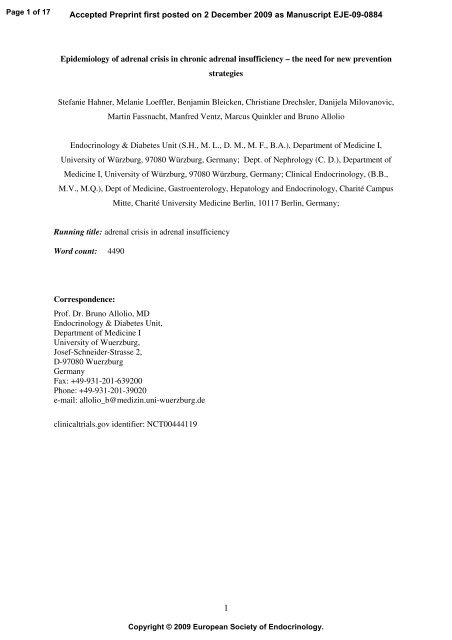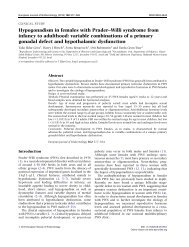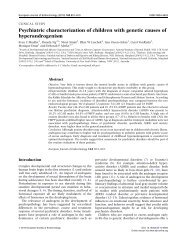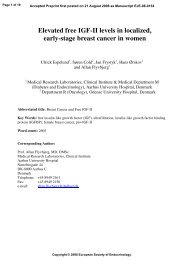Epidemiology of adrenal crisis in chronic adrenal insufficiency – the ...
Epidemiology of adrenal crisis in chronic adrenal insufficiency – the ...
Epidemiology of adrenal crisis in chronic adrenal insufficiency – the ...
You also want an ePaper? Increase the reach of your titles
YUMPU automatically turns print PDFs into web optimized ePapers that Google loves.
Page 1 <strong>of</strong> 17<br />
Accepted Prepr<strong>in</strong>t first posted on 2 December 2009 as Manuscript EJE-09-0884<br />
<strong>Epidemiology</strong> <strong>of</strong> <strong>adrenal</strong> <strong>crisis</strong> <strong>in</strong> <strong>chronic</strong> <strong>adrenal</strong> <strong>in</strong>sufficiency <strong>–</strong> <strong>the</strong> need for new prevention<br />
strategies<br />
Stefanie Hahner, Melanie Loeffler, Benjam<strong>in</strong> Bleicken, Christiane Drechsler, Danijela Milovanovic,<br />
Mart<strong>in</strong> Fassnacht, Manfred Ventz, Marcus Qu<strong>in</strong>kler and Bruno Allolio<br />
Endocr<strong>in</strong>ology & Diabetes Unit (S.H., M. L., D. M., M. F., B.A.), Department <strong>of</strong> Medic<strong>in</strong>e I,<br />
University <strong>of</strong> Würzburg, 97080 Würzburg, Germany; Dept. <strong>of</strong> Nephrology (C. D.), Department <strong>of</strong><br />
Medic<strong>in</strong>e I, University <strong>of</strong> Würzburg, 97080 Würzburg, Germany; Cl<strong>in</strong>ical Endocr<strong>in</strong>ology, (B.B.,<br />
M.V., M.Q.), Dept <strong>of</strong> Medic<strong>in</strong>e, Gastroenterology, Hepatology and Endocr<strong>in</strong>ology, Charité Campus<br />
Mitte, Charité University Medic<strong>in</strong>e Berl<strong>in</strong>, 10117 Berl<strong>in</strong>, Germany;<br />
Runn<strong>in</strong>g title: <strong>adrenal</strong> <strong>crisis</strong> <strong>in</strong> <strong>adrenal</strong> <strong>in</strong>sufficiency<br />
Word count: 4490<br />
Correspondence:<br />
Pr<strong>of</strong>. Dr. Bruno Allolio, MD<br />
Endocr<strong>in</strong>ology & Diabetes Unit,<br />
Department <strong>of</strong> Medic<strong>in</strong>e I<br />
University <strong>of</strong> Wuerzburg,<br />
Josef-Schneider-Strasse 2,<br />
D-97080 Wuerzburg<br />
Germany<br />
Fax: +49-931-201-639200<br />
Phone: +49-931-201-39020<br />
e-mail: allolio_b@mediz<strong>in</strong>.uni-wuerzburg.de<br />
cl<strong>in</strong>icaltrials.gov identifier: NCT00444119<br />
1<br />
Copyright © 2009 European Society <strong>of</strong> Endocr<strong>in</strong>ology.
Abstract<br />
Objective: Adrenal <strong>crisis</strong> (AC) is a life-threaten<strong>in</strong>g complication <strong>of</strong> <strong>adrenal</strong> <strong>in</strong>sufficiency<br />
(AI). Here we evaluated frequency, causes and risk factors <strong>of</strong> AC <strong>in</strong> patients with <strong>chronic</strong> AI.<br />
Methods: In a cross-sectional study 883 patients with AI were contacted by mail. 526 patients<br />
agreed to participate and received a disease specific questionnaire.<br />
Results: 444 data sets were available for analysis (primary <strong>adrenal</strong> <strong>in</strong>sufficiency, PAI n=254,<br />
secondary <strong>adrenal</strong> <strong>in</strong>sufficiency, SAI n=190). 42% (PAI 47%, SAI 35%) reported at least one<br />
<strong>crisis</strong>. 384 AC <strong>in</strong> 6092 patient years were documented (frequency <strong>of</strong> 6.3 crises/100 patient<br />
years). Precipitat<strong>in</strong>g causes were ma<strong>in</strong>ly gastro<strong>in</strong>test<strong>in</strong>al <strong>in</strong>fection and fever (45%) but also<br />
o<strong>the</strong>r stressful events (e.g. major pa<strong>in</strong>, surgery, psychic distress, heat, pregnancy). Sudden<br />
onset <strong>of</strong> apparently unexpla<strong>in</strong>ed AC was also reported (PAI 6.6%, SAI 12.7%). Patients with<br />
PAI reported more frequent emergency glucocorticoid adm<strong>in</strong>istration (42.5% vs 28.4%,<br />
p=0.003)) Crisis <strong>in</strong>cidence was not <strong>in</strong>fluenced by educational status, BMI, glucocorticoid<br />
dose, DHEA treatment, age at diagnosis, hypogonadism, hypothyroidism or growth hormone<br />
deficiency. In PAI, patients with concomitant non-endocr<strong>in</strong>e disease were at higher risk <strong>of</strong><br />
<strong>crisis</strong> (OR=2.02, 95% CI 1.05-3.89, p=0.036). In SAI, female sex (OR=2.18, 95%CI 1.06-4.5,<br />
p=0.035) and diabetes <strong>in</strong>sipidus (RR=2.71, 95%CI 1.22-5.99, p=0.014) were associated with<br />
higher <strong>crisis</strong> <strong>in</strong>cidence.<br />
Conclusion: AC occurs <strong>in</strong> a substantial proportion <strong>of</strong> patients with <strong>chronic</strong> AI, ma<strong>in</strong>ly<br />
triggered by <strong>in</strong>fectious disease. Only a limited number <strong>of</strong> risk factors suitable for target<strong>in</strong>g<br />
prevention <strong>of</strong> AC were identified. These f<strong>in</strong>d<strong>in</strong>gs <strong>in</strong>dicate <strong>the</strong> need for new concepts <strong>of</strong> <strong>crisis</strong><br />
prevention <strong>in</strong> patients with AI.<br />
2<br />
Page 2 <strong>of</strong> 17
Page 3 <strong>of</strong> 17<br />
Introduction<br />
Adrenal <strong>crisis</strong> (AC) is a life threaten<strong>in</strong>g complication <strong>in</strong> patients suffer<strong>in</strong>g from <strong>chronic</strong> <strong>adrenal</strong><br />
<strong>in</strong>sufficiency (AI). It is well known that endogenous cortisol secretion <strong>in</strong>creases substantially <strong>in</strong><br />
response to stressful events <strong>in</strong> healthy subjects. In contrast, patients with AI need to adequately adjust<br />
<strong>the</strong>ir glucocorticoid dose <strong>in</strong> case <strong>of</strong> stress to cover <strong>the</strong> <strong>in</strong>creased demand <strong>in</strong> <strong>adrenal</strong> steroids and to<br />
avert AC. However, <strong>the</strong> cl<strong>in</strong>ical features <strong>of</strong> impend<strong>in</strong>g AC are <strong>of</strong>ten non-specific, lead<strong>in</strong>g to delay <strong>of</strong><br />
emergency glucocorticoid adm<strong>in</strong>istration. Therefore, effective prevention <strong>of</strong> <strong>adrenal</strong> <strong>crisis</strong> rema<strong>in</strong>s a<br />
major challenge <strong>in</strong> <strong>the</strong> care <strong>of</strong> patients with <strong>chronic</strong> AI.<br />
Recent data demonstrates that mortality is <strong>in</strong>creased <strong>in</strong> <strong>chronic</strong> AI 1-3 . In an analysis <strong>of</strong> 1675 patients<br />
with Addison’s disease from <strong>the</strong> National Swedish Hospital and Cause <strong>of</strong> Death Registry 507 deaths<br />
were documented compared to an expected number <strong>of</strong> only 199 deaths. 64 (12.6%) <strong>of</strong> <strong>the</strong>se deaths<br />
were attributed to “endocr<strong>in</strong>e causes” with 36 cases (7.1%) identified as death from AI per se 1 . This<br />
suggests that AC substantially contributes to <strong>the</strong> <strong>in</strong>creased mortality <strong>in</strong> AI.<br />
To date, only limited data is available regard<strong>in</strong>g <strong>in</strong>cidence and precipitat<strong>in</strong>g causes <strong>of</strong> AC ma<strong>in</strong>ly<br />
consist<strong>in</strong>g <strong>of</strong> s<strong>in</strong>gle case reports. In undiagnosed <strong>adrenal</strong> <strong>in</strong>sufficiency, <strong>in</strong>itiation <strong>of</strong> thyrox<strong>in</strong>e<br />
replacement may <strong>in</strong>duce AC due to <strong>in</strong>creased cortisol metabolism 4-6 . Adrenostatic drugs like<br />
etomidate or ketoconazole or drugs that accelerate cortisol metabolism like barbiturates, rifampic<strong>in</strong> or<br />
mitotane may trigger AC 7-9 . In a small survey <strong>in</strong> patients with Addison’s disease 11 <strong>of</strong> 25 patients<br />
(44%) had a history <strong>of</strong> AC requir<strong>in</strong>g <strong>in</strong>patient treatment with <strong>in</strong>travenous hydrocortisone<br />
adm<strong>in</strong>istration 10 . Nagesser et al. 11 reported Addisonian <strong>crisis</strong> requir<strong>in</strong>g hospitalization and treatment<br />
with <strong>in</strong>travenous fluids and corticosteroids <strong>in</strong> 9 <strong>of</strong> 44 patients (20 %) after bilateral <strong>adrenal</strong>ectomy for<br />
Cush<strong>in</strong>g’s disease. Thompson et al. also assessed 39 patients after bilateral <strong>adrenal</strong>ectomy for<br />
Cush<strong>in</strong>g’s disease with a mean duration after <strong>adrenal</strong>ectomy <strong>of</strong> 3.6 years 12 . In <strong>the</strong>ir analysis 9 <strong>of</strong> 39<br />
(23%) patients experienced an <strong>adrenal</strong> <strong>crisis</strong> lead<strong>in</strong>g to hospital admission. In <strong>the</strong> so far largest<br />
retrospective analysis <strong>of</strong> medical records <strong>of</strong> 137 patients with primary and secondary AI, Omori et al.<br />
found that 29% <strong>of</strong> <strong>the</strong>se patients had experienced at least one <strong>adrenal</strong> <strong>crisis</strong> 13 . In <strong>the</strong>ir analysis, mental<br />
disorder and untreated hypogonadism were associated with <strong>the</strong> occurrence <strong>of</strong> AC.<br />
3
To protect patients from life threaten<strong>in</strong>g AC patient education is considered <strong>the</strong> most important<br />
preventive measure 14 . However, efficacy <strong>of</strong> patient education has never been evaluated. Obviously,<br />
def<strong>in</strong><strong>in</strong>g patients at high risk for AC would be helpful to better target specific preventive measures.<br />
Thus, we performed a postal survey <strong>in</strong> a large cohort <strong>of</strong> patients with ei<strong>the</strong>r primary or secondary AI<br />
to fur<strong>the</strong>r assess <strong>the</strong> <strong>in</strong>cidence and precipitat<strong>in</strong>g causes <strong>of</strong> <strong>adrenal</strong> <strong>crisis</strong> and to identify potential risk<br />
factors that may help to improve patient surveillance and education.<br />
Subjects and methods<br />
Patients<br />
A subgroup <strong>of</strong> our patient cohort has previously been described <strong>in</strong> detail 15, 16 . All patients with<br />
AI currently registered with <strong>the</strong> out-patient department at <strong>the</strong> University Hospital Würzburg (n=148)<br />
and <strong>the</strong> University Hospital Charité Berl<strong>in</strong> (n= 535), and registered members <strong>of</strong> <strong>the</strong> German self-help<br />
network <strong>of</strong> patients with pituitary or <strong>adrenal</strong> diseases suffer<strong>in</strong>g from AI (n=200) were asked to<br />
participate <strong>in</strong> a postal survey. The study was approved by <strong>the</strong> ethical committee <strong>of</strong> <strong>the</strong> Universities <strong>of</strong><br />
Würzburg (permit No. 45/04) and Berl<strong>in</strong> (permit No. ES1/037/06) and written <strong>in</strong>formed consent was<br />
obta<strong>in</strong>ed from all patients prior to participation.<br />
The underly<strong>in</strong>g diagnosis <strong>of</strong> AI was verified by review <strong>of</strong> <strong>the</strong> medical records. In addition, <strong>the</strong><br />
follow<strong>in</strong>g exclusion criteria were applied: AI due to previous long-term pharmacological<br />
glucocorticoid treatment, glucocorticoid doses above 7.5 mg prednisolone equivalent for o<strong>the</strong>r reasons<br />
than AI, adrenocortical carc<strong>in</strong>oma, adrenoleukodystrophy, and patients with less than 12 months<br />
duration <strong>of</strong> disease.<br />
Questionnaires<br />
Patients will<strong>in</strong>g to participate received a questionnaire that collected data on duration and<br />
cause <strong>of</strong> AI, hormone replacement <strong>the</strong>rapy, fur<strong>the</strong>r medication, additional endocr<strong>in</strong>e or general health<br />
problems, educational status, occupational status, and <strong>the</strong> self perceived <strong>in</strong>fluence <strong>of</strong> AI on activities<br />
<strong>of</strong> daily life.<br />
Adrenal <strong>crisis</strong> was def<strong>in</strong>ed as acute impairment <strong>of</strong> general health with need <strong>of</strong> <strong>in</strong>travenous<br />
glucocorticoid adm<strong>in</strong>istration and requir<strong>in</strong>g hospital admission. Patients were fur<strong>the</strong>r asked for <strong>the</strong><br />
4<br />
Page 4 <strong>of</strong> 17
Page 5 <strong>of</strong> 17<br />
need <strong>of</strong> emergency <strong>in</strong>travenous glucocorticoid adm<strong>in</strong>istration, frequency and causes <strong>of</strong> AC, equipment<br />
with an emergency card and provision <strong>of</strong> an emergency glucocorticoid kit. For every question patients<br />
had to choose from a list <strong>of</strong> potential answers which were given with tick boxes. In addition, patients<br />
had <strong>the</strong> possibility to add fur<strong>the</strong>r answers as free text.<br />
Statistical analysis<br />
Patients were divided <strong>in</strong>to two groups accord<strong>in</strong>g to <strong>the</strong> presence <strong>of</strong> primary or secondary AI, and<br />
stratified by sex. Cont<strong>in</strong>uous variables were expressed as median with <strong>in</strong>terquartile range, as<br />
appropriate, and categorical variables were expressed as percentages. Comparisons across groups were<br />
calculated by Mann Whitney U test for cont<strong>in</strong>uous variables, and by Chi-square tests for categorical<br />
variables.<br />
The follow<strong>in</strong>g analyses were performed <strong>in</strong> detail. First, <strong>the</strong> self-reported occurrence <strong>of</strong> AC<br />
was determ<strong>in</strong>ed as <strong>the</strong> number <strong>of</strong> events per patient group, and as <strong>in</strong>cidence rate with <strong>the</strong> number <strong>of</strong><br />
events per 100 patient years <strong>in</strong> each group. Second, we determ<strong>in</strong>ed <strong>the</strong> proportions <strong>of</strong> known factors<br />
preced<strong>in</strong>g AC, as reported by <strong>the</strong> patients. Third, we assessed <strong>the</strong> effects <strong>of</strong> potential risk factors on<br />
<strong>the</strong> occurrence <strong>of</strong> AC by b<strong>in</strong>ary logistic regression analyses. Odds ratios (OR) with 95% confidence<br />
<strong>in</strong>tervals were calculated for <strong>the</strong> whole group <strong>of</strong> patients, and stratified by primary or secondary<br />
<strong>adrenal</strong> <strong>in</strong>sufficiency. Potential risk factors to be evaluated <strong>in</strong>cluded DHEA replacement,<br />
glucocorticoid dose per body surface area, age at diagnosis, sex, educational status, prevalence <strong>of</strong><br />
diabetes <strong>in</strong>sipidus (<strong>in</strong> SAI), prevalence <strong>of</strong> concomitant disease, cause <strong>of</strong> AI (primary vs secondary),<br />
fludrocortisone dose (<strong>in</strong> PAI), and body mass <strong>in</strong>dex (BMI). We performed univariate and multivariate<br />
analyses, <strong>the</strong> latter <strong>in</strong>clud<strong>in</strong>g all <strong>of</strong> <strong>the</strong> above mentioned variables. All p-values are reported two-sided<br />
and considered statistically significant at a level
From 883 patients with previously documented <strong>adrenal</strong> <strong>in</strong>sufficiency which were <strong>in</strong>itially contacted,<br />
526 sent an <strong>in</strong>formed consent form back and received questionnaires. 62 patients were subsequently<br />
excluded after review <strong>of</strong> <strong>the</strong> medical records because <strong>the</strong>y did not fulfil <strong>the</strong> <strong>in</strong>clusion and exclusion<br />
criteria or due to <strong>in</strong>sufficient data. 444 patients were available for analysis. Data on age, duration <strong>of</strong><br />
disease, underly<strong>in</strong>g diagnosis and hormone replacement is given <strong>in</strong> tables 1 and 2.<br />
Frequency <strong>of</strong> <strong>adrenal</strong> <strong>crisis</strong> <strong>in</strong> primary and secondary <strong>adrenal</strong> <strong>in</strong>sufficiency<br />
In this survey, a total <strong>of</strong> 384 AC <strong>in</strong> 6092 patient years were documented correspond<strong>in</strong>g to an <strong>in</strong>cidence<br />
rate <strong>of</strong> 6.3 crises per 100 patient years (6.6 <strong>in</strong> primary AI, 5.8 <strong>in</strong> secondary AI). In terms <strong>of</strong> overall<br />
frequencies, at least one AC was reported by 185 <strong>of</strong> 444 patients (41.7%) (119/254 <strong>of</strong> patients with<br />
primary AI (46.9%) and 66/190 <strong>of</strong> patients with secondary AI (34.9%)) (Table 3). 95 (21.4%) patients<br />
reported more than one AC (PAI 24%, SAI 18%). Fur<strong>the</strong>rmore, need <strong>of</strong> i.v. glucocorticoid<br />
adm<strong>in</strong>istration <strong>in</strong> an outpatient sett<strong>in</strong>g was reported by 108/254 (42.5 %) <strong>of</strong> <strong>the</strong> patients with primary<br />
AI and by 54/190 (28.4%) <strong>of</strong> <strong>the</strong> patients with secondary AI.<br />
Precipitat<strong>in</strong>g factors<br />
Precipitat<strong>in</strong>g factors are summarized <strong>in</strong> Table 4. Most important factors were <strong>in</strong>fectious diseases,<br />
particularly gastro<strong>in</strong>test<strong>in</strong>al <strong>in</strong>fections. Fur<strong>the</strong>r causes were perioperative condition (PAI 7.2%, SAI<br />
15.5% <strong>of</strong> cases), exhaustive physical activity (PAI 7.7%, SAI 7.3% <strong>of</strong> cases), cessation <strong>of</strong><br />
glucocorticoid replacement by <strong>the</strong> patient (PAI 5%, SAI 6.4% <strong>of</strong> cases) or <strong>the</strong> attend<strong>in</strong>g physician<br />
(PAI 1.1%, SAI 3.6%), psychic distress (PAI 3.3%, SAI 3.6%), accidents (PAI 2.8%, SAI 2.7%). Also<br />
severe migra<strong>in</strong>e, long distance flight, <strong>in</strong>cident atrial fibrillation, climatic change with heat, grand mal<br />
epilepsy were reported as precipitat<strong>in</strong>g causes <strong>of</strong> AC. In a substantial proportion <strong>of</strong> cases no<br />
underly<strong>in</strong>g cause could be identified (PAI 6.6%, SAI 12.7% <strong>of</strong> cases).<br />
Risk factors for <strong>adrenal</strong> <strong>crisis</strong><br />
Risk factor assessment was performed for <strong>the</strong> variables DHEA replacement, glucocorticoid dose per<br />
body surface area, age at diagnosis, sex, educational status, prevalence <strong>of</strong> diabetes <strong>in</strong>sipidus (<strong>in</strong> SAI),<br />
6<br />
Page 6 <strong>of</strong> 17
Page 7 <strong>of</strong> 17<br />
prevalence <strong>of</strong> concomitant disease, cause <strong>of</strong> AI (primary vs secondary), fludrocortisone dose (<strong>in</strong> PAI),<br />
and BMI (Table 5).<br />
Primary AI was associated with a higher <strong>in</strong>cidence <strong>of</strong> AC <strong>in</strong> comparison to <strong>the</strong> patients with secondary<br />
AI (PAI: OR 0.51, 95% CI 0.27-0.97, p=0.04). In PAI, patients with concomitant non-endocr<strong>in</strong>e<br />
disease were at higher risk for AC (OR=2.02, 95% CI 1.05-3.89, p=0.04). In SAI, female gender<br />
(OR=2.18, 95% CI 1.06-4.5, p=0.04) and diabetes <strong>in</strong>sipidus (OR=2.71, 95% CI 1.22-5.99, p=0.01)<br />
were significantly associated with <strong>the</strong> <strong>in</strong>cidence <strong>of</strong> AC.<br />
Emergency equipment, patient education and dose adaptation<br />
93.8% <strong>of</strong> patients carried an emergency card and 29.6% <strong>of</strong> patients were equipped with an emergency<br />
kit (glucocorticoid suppositories or glucocorticoid ampules for iv. <strong>in</strong>jection), respectively. On <strong>the</strong><br />
o<strong>the</strong>r hand 9.9% <strong>of</strong> patients reported that <strong>the</strong>y never had <strong>in</strong>creased <strong>the</strong>ir glucocorticoid dose.<br />
Regard<strong>in</strong>g patient education on <strong>crisis</strong> prevention and glucocorticoid dose adaptation 15.6 % felt “very<br />
well” <strong>in</strong>formed, 48.1% “well” <strong>in</strong>formed, 28.5% “nei<strong>the</strong>r well nor badly”, 6.7% “badly” and 1.1%<br />
“very badly” <strong>in</strong>formed. This did not correlate with frequency <strong>of</strong> AC or emergency glucocorticoid<br />
adm<strong>in</strong>istration.<br />
Discussion<br />
In this retrospective study we have analyzed <strong>the</strong> epidemiology <strong>of</strong> AC <strong>in</strong> a large cohort <strong>of</strong> patients with<br />
primary and secondary AI. Adrenal crises occur <strong>in</strong> a substantial proportion <strong>of</strong> patients with AI with an<br />
overall frequency <strong>of</strong> 6.3 AC per 100 patient years, which is higher than <strong>the</strong> frequency <strong>of</strong> 3.3 AC per<br />
100 patient years reported by Arlt et al <strong>in</strong> 53 patients with PAI or SAI 14 . 7.4% <strong>of</strong> <strong>the</strong> patients with SAI<br />
and 10.6% <strong>of</strong> <strong>the</strong> patients with PAI experienced four or more <strong>adrenal</strong> crises. Similarly, <strong>in</strong> <strong>the</strong><br />
<strong>in</strong>ternational Addison’s survey <strong>of</strong> <strong>the</strong> UK Addison’s disease self help group 47% <strong>of</strong> <strong>the</strong> participants<br />
reported that <strong>the</strong>y had needed emergency treatment at a hospital s<strong>in</strong>ce <strong>the</strong>ir diagnosis, and <strong>of</strong> <strong>the</strong>se<br />
10% reported that <strong>the</strong>y had needed emergency hospital treatment on four or more occasions 17 . Thus,<br />
AC is relatively common <strong>in</strong> patients with PAI or SAI with a frequency <strong>in</strong> <strong>the</strong> same order <strong>of</strong> magnitude<br />
as severe hypoglycaemia requir<strong>in</strong>g assistance <strong>in</strong> patients with diabetes mellitus (about 10 per 100<br />
patient years) 18, 19 .<br />
7
Ma<strong>in</strong> trigger for <strong>adrenal</strong> <strong>crisis</strong> <strong>in</strong> our patient cohort were <strong>in</strong>fectious diseases compris<strong>in</strong>g 45% <strong>of</strong> all<br />
events. In a recent analysis <strong>of</strong> 1675 patients with primary <strong>adrenal</strong> <strong>in</strong>sufficiency from Sweden, all cause<br />
mortality was <strong>in</strong>creased with a risk ratio <strong>of</strong> 2.19 for men and 2.86 for women 1 . The risk ratio was<br />
highest for mortality from <strong>in</strong>fectious disease (6.57 for men, 5.57 for women, respectively) which<br />
emphasizes that patients with AI are at pronouncedly <strong>in</strong>creased risk under conditions <strong>of</strong> <strong>in</strong>fection.<br />
Slightly supraphysiological glucocorticoid replacement may predispose to <strong>in</strong>fections 20 and<br />
<strong>in</strong>appropriate adaptation <strong>of</strong> glucocorticoid dose dur<strong>in</strong>g <strong>in</strong>fectious illness may fur<strong>the</strong>r enhance this risk.<br />
However, also severe migra<strong>in</strong>e, long distance flight, <strong>in</strong>cident atrial fibrillation, climatic change with<br />
heat, grand mal epilepsy or <strong>in</strong>sufficient dose adaptation dur<strong>in</strong>g pregnancy were reported as<br />
precipitat<strong>in</strong>g factors <strong>of</strong> AC. Particularly climatic change with exposure to unusual heat was repeatedly<br />
reported as a condition that requires an <strong>in</strong>crease <strong>of</strong> <strong>the</strong> replacement dose, <strong>in</strong> PAI probably also<br />
<strong>in</strong>dicat<strong>in</strong>g <strong>the</strong> need <strong>of</strong> <strong>in</strong>creased m<strong>in</strong>eralocorticoid replacement. However, adjustment <strong>of</strong><br />
m<strong>in</strong>eralocorticoid dose is rarely considered by both patients and physicians.<br />
Also psychic distress appears to be associated with a significantly <strong>in</strong>creased demand <strong>of</strong><br />
glucocorticoids. This was observed <strong>in</strong> 3.3% <strong>of</strong> <strong>the</strong> patients with PAI and 3.6% <strong>of</strong> <strong>the</strong> patients with SAI<br />
who reported that severe psychic distress had led to <strong>adrenal</strong> <strong>crisis</strong>.<br />
In many cases <strong>the</strong> cause <strong>of</strong> AC rema<strong>in</strong>ed unknown. This might <strong>in</strong> part be due to <strong>the</strong> retrospective<br />
character <strong>of</strong> this survey. However, <strong>in</strong> our experience AC sometimes develops rapidly without a clearly<br />
identifiable cause.<br />
In an attempt to def<strong>in</strong>e risk factors for AC Omori et al 13 retrospectively analyzed <strong>the</strong> medical records<br />
<strong>of</strong> 22 patients with PAI and 115 patients with SAI. In this study no difference <strong>in</strong> <strong>the</strong> frequency <strong>of</strong> AC<br />
between <strong>the</strong> patients with PAI and SAI was observed. However, patients with PAI may have been<br />
underrepresented. The authors identified mental retardation, age at diagnosis <strong>of</strong> >20 years and diabetes<br />
<strong>in</strong>sipidus as risk factors for AC. In our analysis we could not detect a relation to age at diagnosis or<br />
educational status. As most <strong>of</strong> our hypogonadal patients received replacement treatment for<br />
hypogonadism we could not evaluate if untreated hypogonadism represents a fur<strong>the</strong>r risk factor as<br />
described by Omori et al.. However, also <strong>in</strong> our cohort, diabetes <strong>in</strong>sipidus was associated with an<br />
<strong>in</strong>creased risk <strong>of</strong> AC <strong>in</strong> SAI patients. Thus, impaired vasopress<strong>in</strong> secretion may be an important<br />
pathophysiological factor. Replacement with desmopress<strong>in</strong> <strong>in</strong> diabetes <strong>in</strong>sipidus activates V2 receptors<br />
8<br />
Page 8 <strong>of</strong> 17
Page 9 <strong>of</strong> 17<br />
only and activation <strong>of</strong> V1 receptors may be miss<strong>in</strong>g dur<strong>in</strong>g severe stress <strong>in</strong> <strong>the</strong>se patients <strong>the</strong>reby<br />
precipitat<strong>in</strong>g AC. In a previous analysis females with Addison’s disease were at higher risk to develop<br />
AC 14 . This is <strong>in</strong> concordance with our observations, also demonstrat<strong>in</strong>g a higher risk for AC <strong>in</strong><br />
females with PAI. The reason for this female preponderance rema<strong>in</strong>s to be elucidated. Fur<strong>the</strong>rmore,<br />
patients with primary AI experienced significantly more AC than patients with secondary AI,<br />
suggest<strong>in</strong>g that lack <strong>of</strong> m<strong>in</strong>eralocorticoids may represent a relevant additional risk factor.<br />
Based on a postal survey <strong>in</strong> 97 patients from <strong>the</strong> Ne<strong>the</strong>rlands, Flemm<strong>in</strong>g et al have demonstrated that<br />
46% <strong>of</strong> patients were not sufficiently skilled <strong>in</strong> cop<strong>in</strong>g with stress, whereas 60% felt <strong>the</strong>mselves to be<br />
well <strong>in</strong>formed 21 . In our cohort 62.8% felt well or very well <strong>in</strong>formed. However, no correlation with<br />
<strong>the</strong> frequency <strong>of</strong> AC could be detected, clearly <strong>in</strong>dicat<strong>in</strong>g <strong>the</strong> need for improved prevention strategies.<br />
While diabetic patients and <strong>the</strong>ir partners undergo <strong>in</strong>tensive and repeated structured education<br />
regard<strong>in</strong>g prevention and handl<strong>in</strong>g <strong>of</strong> severe hypoglycaemia, patient education <strong>in</strong> AI is not yet well<br />
structured. Fur<strong>the</strong>rmore, evaluation <strong>of</strong> <strong>the</strong> effectiveness <strong>of</strong> patient education has never been performed.<br />
Although almost all our patients carried an emergency card, AC occurred <strong>in</strong> a substantial number <strong>of</strong><br />
patients suggest<strong>in</strong>g that current prevention strategies are not sufficient to protect from AC. Improved<br />
strategies may not only <strong>in</strong>clude a validated structured education <strong>of</strong> patients, but also more widespread<br />
provision with an emergency glucocorticoid set for i.v. adm<strong>in</strong>istration, and education <strong>of</strong> family<br />
members <strong>in</strong>clud<strong>in</strong>g tra<strong>in</strong><strong>in</strong>g <strong>in</strong> <strong>the</strong> use <strong>of</strong> emergency glucocorticoids. Early aggressive treatment <strong>of</strong><br />
<strong>in</strong>fectious diseases is mandatory and establishment <strong>of</strong> an emergency hotl<strong>in</strong>e for both patients and<br />
attend<strong>in</strong>g physicians should be considered to m<strong>in</strong>imize hospitalisation for AC and to completely<br />
elim<strong>in</strong>ate death from AC <strong>in</strong> patients with known <strong>chronic</strong> AI. The efficacy <strong>of</strong> such measures has to be<br />
evaluated <strong>in</strong> prospective studies.<br />
Our study has several limitations: First, it is a retrospective <strong>in</strong>vestigation <strong>in</strong> patients suffer<strong>in</strong>g from<br />
<strong>adrenal</strong> disease for up to 57 years. Thus it might have been difficult to exactly remember <strong>the</strong> number,<br />
precipitat<strong>in</strong>g factors and circumstances <strong>of</strong> every <strong>adrenal</strong> <strong>crisis</strong>. Fur<strong>the</strong>r, it is difficult to judge <strong>in</strong> all<br />
cases whe<strong>the</strong>r true AC was present. Hydrocortisone may have been adm<strong>in</strong>istered <strong>in</strong>travenously as pre-<br />
emptive action to avert cl<strong>in</strong>ical aggravation. In many cases gastro<strong>in</strong>test<strong>in</strong>al <strong>in</strong>fection was <strong>in</strong>dicated as<br />
cause <strong>of</strong> AC. However, it is <strong>of</strong>ten unclear if a gastro<strong>in</strong>test<strong>in</strong>al <strong>in</strong>fection was actually <strong>the</strong> underly<strong>in</strong>g<br />
9
cause or if diarrhea and vomit<strong>in</strong>g were already manifestations <strong>of</strong> AC. There might be some risk <strong>of</strong><br />
overestimation <strong>of</strong> <strong>in</strong>cidence <strong>of</strong> <strong>adrenal</strong> <strong>crisis</strong> as patients from <strong>the</strong> self help group were <strong>in</strong>cluded and<br />
patients that have no or only m<strong>in</strong>or compla<strong>in</strong>ts might not have participated. However, <strong>in</strong> our cohort<br />
40% <strong>of</strong> <strong>the</strong> patients from <strong>the</strong> self help group experienced at least one <strong>adrenal</strong> <strong>crisis</strong> compared to 42%<br />
<strong>of</strong> <strong>the</strong> patients from <strong>the</strong> University Hospitals Berl<strong>in</strong> and Würzburg.<br />
Fur<strong>the</strong>rmore, <strong>in</strong>cidence, causes and risk factors <strong>of</strong> <strong>adrenal</strong> <strong>crisis</strong> were only one aspect <strong>of</strong> <strong>the</strong> survey<br />
that also evaluated fur<strong>the</strong>r aspects <strong>of</strong> <strong>the</strong> <strong>adrenal</strong> disease (e. g. subjective health status, replacement<br />
regimens, problems prior diagnosis <strong>of</strong> <strong>adrenal</strong> <strong>in</strong>sufficiency, etc.) 15, 16, 22 .<br />
The exact <strong>in</strong>cidence and causes <strong>of</strong> AC have to be addressed <strong>in</strong> a prospective trial.<br />
In conclusion, AC occurs <strong>in</strong> a substantial proportion <strong>of</strong> both PAI and SAI patients, ma<strong>in</strong>ly triggered by<br />
<strong>in</strong>fectious disease. However, also several o<strong>the</strong>r causes need to be taken <strong>in</strong>to account for adjustments <strong>of</strong><br />
<strong>the</strong> glucocorticoid dose. The regular occurrence <strong>of</strong> life-threaten<strong>in</strong>g AC <strong>in</strong> seem<strong>in</strong>gly well educated<br />
patients clearly <strong>in</strong>dicates <strong>the</strong> need for improved prevention strategies.<br />
This work was supported by <strong>the</strong> Wilhelm-Sander-Stiftung (project grants 2003.175.1 and 2003.175.2<br />
to B.A. and S.H.)<br />
Disclosure statement: The authors have noth<strong>in</strong>g to disclose.<br />
Acknowledgement<br />
We are <strong>in</strong>debted to Sven Diederich, Re<strong>in</strong>hard F<strong>in</strong>ke and Ullrich Bogner, all Berl<strong>in</strong>, for recruitment <strong>of</strong><br />
patients. We thank Pr<strong>of</strong>. J. Hensen, Pr<strong>of</strong>. C. Schöfl, Mrs Hummel, Mrs Jalowski and Mrs Stahl from<br />
<strong>the</strong> German Self-Help Network for Pituitary and Adrenal Diseases “Netzwerk Hypophysen- und<br />
Nebennierenerkrankungen e. V.” for <strong>the</strong>ir <strong>in</strong>valuable support by contact<strong>in</strong>g <strong>the</strong> patients <strong>of</strong> this network<br />
and distribut<strong>in</strong>g <strong>the</strong> questionnaires.<br />
10<br />
Page 10 <strong>of</strong> 17
Page 11 <strong>of</strong> 17<br />
Literature<br />
1. Bergthorsdottir R, Leonsson-Zachrisson M, Oden A & Johannsson G. Premature<br />
mortality <strong>in</strong> patients with Addison's disease: a population-based study. J Cl<strong>in</strong><br />
Endocr<strong>in</strong>ol Metab 2006 91 4849-4853.<br />
2. Erichsen MM, Lovas K, Fougner KJ, Svartberg J, Hauge ER, Bollerslev J, Berg JP,<br />
Mella B & Husebye ES. Normal overall mortality rate <strong>in</strong> Addison's disease, but young<br />
patients are at risk <strong>of</strong> premature death. Eur J Endocr<strong>in</strong>ol 2009 160 233-237.<br />
3. Shulman DI, Palmert MR & Kemp SF. Adrenal <strong>in</strong>sufficiency: still a cause <strong>of</strong><br />
morbidity and death <strong>in</strong> childhood. Pediatrics 2007 119 e484-494.<br />
4. Graves L, 3rd, Kle<strong>in</strong> RM & Wall<strong>in</strong>g AD. Addisonian <strong>crisis</strong> precipitated by thyrox<strong>in</strong>e<br />
<strong>the</strong>rapy: a complication <strong>of</strong> type 2 autoimmune polyglandular syndrome. South Med J<br />
2003 96 824-827.<br />
5. Davis J & Sheppard M. Acute <strong>adrenal</strong> <strong>crisis</strong> precipitated by thyrox<strong>in</strong>e. Br Med J (Cl<strong>in</strong><br />
Res Ed) 1986 292 1595.<br />
6. Fonseca V, Brown R, Hochhauser D, G<strong>in</strong>sburg J & Havard CW. Acute <strong>adrenal</strong> <strong>crisis</strong><br />
precipitated by thyrox<strong>in</strong>e. Br Med J (Cl<strong>in</strong> Res Ed) 1986 292 1185-1186.<br />
7. Lundy JB, Slane ML & Frizzi JD. Acute <strong>adrenal</strong> <strong>in</strong>sufficiency after a s<strong>in</strong>gle dose <strong>of</strong><br />
etomidate. J Intensive Care Med 2007 22 111-117.<br />
8. Sarver RG, Dalk<strong>in</strong> BL & Ahmann FR. Ketoconazole-<strong>in</strong>duced <strong>adrenal</strong> <strong>crisis</strong> <strong>in</strong> a<br />
patient with metastatic prostatic adenocarc<strong>in</strong>oma: case report and review <strong>of</strong> <strong>the</strong><br />
literature. Urology 1997 49 781-785.<br />
9. Khosla S, Wolfson JS, Demerjian Z & God<strong>in</strong>e JE. Adrenal <strong>crisis</strong> <strong>in</strong> <strong>the</strong> sett<strong>in</strong>g <strong>of</strong> highdose<br />
ketoconazole <strong>the</strong>rapy. Arch Intern Med 1989 149 802-804.<br />
10. Braatvedt GD, Newrick PG & Corrall RJ. Patients' self adm<strong>in</strong>istration <strong>of</strong><br />
hydrocortisone. Bmj 1990 301 1312.<br />
11. Nagesser SK, van Seters AP, Kievit J, Hermans J, Krans HM & van de Velde CJ.<br />
Long-term results <strong>of</strong> total <strong>adrenal</strong>ectomy for Cush<strong>in</strong>g's disease. World J Surg 2000 24<br />
108-113.<br />
12. Thompson SK, Hayman AV, Ludlam WH, Deveney CW, Loriaux DL & Sheppard<br />
BC. Improved quality <strong>of</strong> life after bilateral laparoscopic <strong>adrenal</strong>ectomy for Cush<strong>in</strong>g's<br />
disease: a 10-year experience. Ann Surg 2007 245 790-794.<br />
13. Omori K, Nomura K, Shimizu S, Omori N & Takano K. Risk factors for <strong>adrenal</strong> <strong>crisis</strong><br />
<strong>in</strong> patients with <strong>adrenal</strong> <strong>in</strong>sufficiency. Endocr J 2003 50 745-752.<br />
14. Arlt W & Allolio B. Adrenal <strong>in</strong>sufficiency. Lancet 2003 361 1881-1893.<br />
15. Hahner S, Loeffler M, Fassnacht M, Weismann D, Koschker AC, Qu<strong>in</strong>kler M, Decker<br />
O, Arlt W & Allolio B. Impaired subjective health status <strong>in</strong> 256 patients with <strong>adrenal</strong><br />
<strong>in</strong>sufficiency on standard <strong>the</strong>rapy based on cross-sectional analysis. J Cl<strong>in</strong> Endocr<strong>in</strong>ol<br />
Metab 2007 92 3912-3922.<br />
16. Bleicken B, Hahner S, Loeffler M, Ventz M, Allolio B & Qu<strong>in</strong>kler M. Impaired<br />
subjective health status <strong>in</strong> <strong>chronic</strong> <strong>adrenal</strong> <strong>in</strong>sufficiency: impact <strong>of</strong> different<br />
glucocorticoid replacement regimens. Eur J Endocr<strong>in</strong>ol 2008 159 811-817.<br />
17. White K & Arlt W. Adrenal <strong>crisis</strong> <strong>in</strong> treated Addison's disease: a predictable but<br />
under-managed event. Eur J Endocr<strong>in</strong>ol 2009.<br />
18. Shalit<strong>in</strong> S & Phillip M. Hypoglycemia <strong>in</strong> type 1 diabetes: a still unresolved problem <strong>in</strong><br />
<strong>the</strong> era <strong>of</strong> <strong>in</strong>sul<strong>in</strong> analogs and pump <strong>the</strong>rapy. Diabetes Care 2008 31 Suppl 2 S121-<br />
124.<br />
19. Sw<strong>in</strong>nen SG, Mull<strong>in</strong>s P, Miller M, Hoekstra JB & Holleman F. Chang<strong>in</strong>g <strong>the</strong> glucose<br />
cut-<strong>of</strong>f values that def<strong>in</strong>e hypoglycaemia has a major effect on reported frequencies <strong>of</strong><br />
hypoglycaemia. Diabetologia 2009 52 38-41.<br />
11
20. Saag KG, Koehnke R, Caldwell JR, Bras<strong>in</strong>gton R, Burmeister LF, Zimmerman B,<br />
Kohler JA & Furst DE. Low dose long-term corticosteroid <strong>the</strong>rapy <strong>in</strong> rheumatoid<br />
arthritis: an analysis <strong>of</strong> serious adverse events. Am J Med 1994 96 115-123.<br />
21. Flemm<strong>in</strong>g TG & Kristensen LO. Quality <strong>of</strong> self-care <strong>in</strong> patients on replacement<br />
<strong>the</strong>rapy with hydrocortisone. J Intern Med 1999 246 497-501.<br />
22. Bleicken B, Hahner S, Loeffler M, Ventz M, Decker O, Allolio B & Qu<strong>in</strong>kler M.<br />
Influence <strong>of</strong> hydrocortisone dosage scheme on health related quality <strong>of</strong> life <strong>in</strong> patients<br />
with <strong>adrenal</strong> <strong>in</strong>sufficiency. Cl<strong>in</strong> Endocr<strong>in</strong>ol (Oxf) 2009.<br />
12<br />
Page 12 <strong>of</strong> 17
Page 13 <strong>of</strong> 17<br />
Table 1: Age, duration <strong>of</strong> disease and underly<strong>in</strong>g diagnosis <strong>in</strong> 444 patients with <strong>adrenal</strong><br />
<strong>in</strong>sufficiency<br />
Primary <strong>adrenal</strong> <strong>in</strong>sufficiency men (n=63) women (n=191)<br />
age (years)<br />
median (range) 46 (20-84) 46 (20-80)<br />
duration <strong>of</strong> disease (years)<br />
median (range) 10 (1-50) 12 (1-45)<br />
Cause <strong>of</strong> <strong>adrenal</strong> <strong>in</strong>sufficiency (n)<br />
autoimmune <strong>adrenal</strong>itis 25 140<br />
bilateral <strong>adrenal</strong>ectomy 13 29<br />
CAH 8 18<br />
tuberculosis 3 3<br />
unknown 14 1<br />
Secondary <strong>adrenal</strong> <strong>in</strong>sufficiency men (n=77) women (n=113)<br />
age (years)<br />
median (range) 59 (23-78) 54 (17-81)<br />
duration <strong>of</strong> disease (years)<br />
median (range) 10 (1-41) 10 (1-57)<br />
Cause <strong>of</strong> <strong>adrenal</strong> <strong>in</strong>sufficiency (n)<br />
pituitary adenoma 46 61<br />
o<strong>the</strong>r <strong>in</strong>tracerebral tumours * 10 20<br />
lymphocytic hypophysitis 0 1<br />
sarcoidosis 1 1<br />
isolated ACTH deficiency 2 1<br />
aneurysm <strong>of</strong> <strong>the</strong> ant. a. communicans 1 0<br />
Empty sella 1 2<br />
Bra<strong>in</strong> <strong>in</strong>jury 1 1<br />
Sheehan's syndrome - 12<br />
congenital dysplasia <strong>of</strong> pituitary 0 1<br />
unknown 15 13<br />
* o<strong>the</strong>r <strong>in</strong>tracerebral tumours: craniopharyngeoma (n= 22), sella turcica men<strong>in</strong>geoma (n=2), cholesterol<br />
granuloma (n=1), dermoid cyst (n=1), opticus glioma (n=1), cyst at pituitary (n=3)<br />
CAH = congenital <strong>adrenal</strong> hyperplasia
Table 2: Hormone replacement <strong>the</strong>rapy <strong>in</strong> 444 patients with <strong>adrenal</strong> <strong>in</strong>sufficiency (AI).<br />
primary <strong>adrenal</strong> <strong>in</strong>sufficiency (n=254)<br />
AI specific replacement <strong>the</strong>rapy<br />
men (n=63)<br />
*mostly <strong>in</strong> comb<strong>in</strong>ation with hydrocortisone, prednisolone or cortisone acetate<br />
n<br />
Dose (mg/d)<br />
median (range)<br />
n<br />
women (n=191)<br />
Dose (mg/d)<br />
median (range)<br />
hydrocortisone 48 25 (10-50) 161 20 (5-45)<br />
cortisone acetate 7 50 (37.5-100) 5 37.5 (37.5-100)<br />
prednisolone 6 5 (5-7.5) 24 5 (2-10)<br />
dexamethasone* 4 0.25 (0.25-0.5) 7 0.25 (0.25-1.5)<br />
fludrocortisone 56 0.1 (0.05-0.2) 173 0.1 (0.03-0.5)<br />
dehydroepiandrosterone 3 25 (25-25) 61 25 (12.5-25)<br />
secondary <strong>adrenal</strong> <strong>in</strong>sufficiency (n=190)<br />
AI specific replacement <strong>the</strong>rapy<br />
n<br />
men (n=77)<br />
Dose (mg/d)<br />
median (range)<br />
n<br />
women (n=113)<br />
Dose (mg/d)<br />
median (range)<br />
hydrocortisone 55 20 (10-50) 89 20 (5-35)<br />
cortisone acetate 2 25 (25-25) 5 37.5 (31.5-43.7)<br />
prednisolone 20 5 (2.5-7.5) 17 5 (2.5-7.5)<br />
dexamethasone* 0 - 1 0.25<br />
dehydroepiandrosterone 3 25 (25-25) 4 25 (12.5-25)<br />
Page 14 <strong>of</strong> 17
Page 15 <strong>of</strong> 17<br />
Table 3 Frequency <strong>of</strong> <strong>adrenal</strong> <strong>crisis</strong> (AC) <strong>in</strong> patients with primary (PAI) and secondary<br />
<strong>adrenal</strong> <strong>in</strong>sufficiency (SAI)<br />
PAI<br />
SAI<br />
(n=254)<br />
(n=190)<br />
no <strong>of</strong> AC n % n %<br />
0 135 53.1 124 65.1<br />
1 58 22.8 32 16.9<br />
2 24 9.4 8 4.2<br />
3 10 3.9 12 6.3<br />
≥4 27 10.6 14 7.4
Table 4 Precipitat<strong>in</strong>g factors for Adrenal Crisis<br />
Precipitat<strong>in</strong>g factors for <strong>adrenal</strong> <strong>crisis</strong> were reported for 181 cases <strong>in</strong> patients with primary<br />
<strong>adrenal</strong> <strong>in</strong>sufficiency (PAI) and for 110 cases <strong>in</strong> patients with secondary <strong>adrenal</strong> <strong>in</strong>sufficiency<br />
(SAI).<br />
PAI SAI<br />
% <strong>of</strong> % <strong>of</strong><br />
n cases n cases<br />
Gastro<strong>in</strong>test<strong>in</strong>al <strong>in</strong>fection 59 32.6 24 21.8<br />
o<strong>the</strong>r <strong>in</strong>fectious disease/ fever 44 24.3 19 17.3<br />
Surgery 13 7.2 17 15.5<br />
Unknown 12 6.6 14 12.7<br />
Strenous physical activity<br />
Cessation <strong>of</strong> glucocorticoid substitution by<br />
14 7.7 8 7.3<br />
patient 9 5.0 7 6.4<br />
Neglected glucocorticoid <strong>in</strong>take 9 5.0 4 3.6<br />
Psychic distress 6 3.3 4 3.6<br />
Accident<br />
Cessation <strong>of</strong> glucocorticoid substitution by<br />
5 2.8 3 2.7<br />
attend<strong>in</strong>g physician 2 1.1 4 3.6<br />
O<strong>the</strong>r reasons * 8 4.4 6 5.4<br />
*O<strong>the</strong>r reasons: Primary <strong>adrenal</strong> <strong>in</strong>sufficiency (PAI): e.g. migra<strong>in</strong>e, after long-distance flight, atrial fibrillation,<br />
<strong>in</strong>sufficient dose adaptation dur<strong>in</strong>g pregnancy; Secondary <strong>adrenal</strong> <strong>in</strong>sufficiency (SAI): e.g. difficulties with<br />
adjustment <strong>of</strong> substitution dose, climatic change (heat), grand mal epilepsy.<br />
Page 16 <strong>of</strong> 17
Page 17 <strong>of</strong> 17<br />
Table 5 Risk factors for <strong>adrenal</strong> <strong>crisis</strong>.<br />
Adrenal <strong>crisis</strong> with hospital<br />
admission<br />
All patients (n=444)<br />
Odds<br />
ratio<br />
95% confidence<br />
<strong>in</strong>terval p<br />
DHEA replacement 0.88 0.52-1.49 0.63<br />
Glucocorticoid<br />
dose/BSA 1.02 0.98-1.07 0.32<br />
Age at diagnosis 0.98 0.96-1.01 0.12<br />
Female sex 1.66 1.00-2.75 0.05<br />
Educational status 1.22 0.70-2.14 0.49<br />
Concomitant disease 1.81 1.13-2.90 0.01<br />
BMI 0.98 0.93-1.03 0.40<br />
SAI vs PAI 0.51 0.27-0.97 0.04<br />
Patients with PAI<br />
(n= 254)<br />
DHEA replacement 0.82 0.40-1.72 0.60<br />
Glucocorticoid<br />
dose/BSA 1.02 0.96-1.08 0.50<br />
Fludrocortisone dose 0.84 0.38-1.88 0.68<br />
Age at diagnosis* 0.96 0.93-0.99 0.02<br />
Female sex 1.60 0.74-3.44 0.23<br />
Educational status 0.90 0.37-2.19 0.82<br />
Concomitant disease 2.02 1.05-3.89 0.04<br />
BMI 0.995 0.91-1.08 0.90<br />
Patients with SAI<br />
(n= 189)<br />
DHEA replacement 0.92 0.33-2.55 0.87<br />
Glucocorticoid<br />
dose/BSA 1.04 0.96-1.12 0.32<br />
Age at diagnosis 0.98 0.94-1.01 0.21<br />
Female sex 2.18 1.06-4.50 0.04<br />
Diabetes <strong>in</strong>sipidus 2.71 1.22-5.99 0.01<br />
Educational status 1.48 0.62-3.56 0.38<br />
Concomitant disease 1.58 0.66-3.77 0.31<br />
BMI 0.983 0.91-1.06 0.67<br />
BSA = body surface area; DHEA = dehydroepiandrosterone; BMI = body mass <strong>in</strong>dex.<br />
* Age at diagnosis was negatively correlated with frequency <strong>of</strong> <strong>adrenal</strong> <strong>crisis</strong>.









